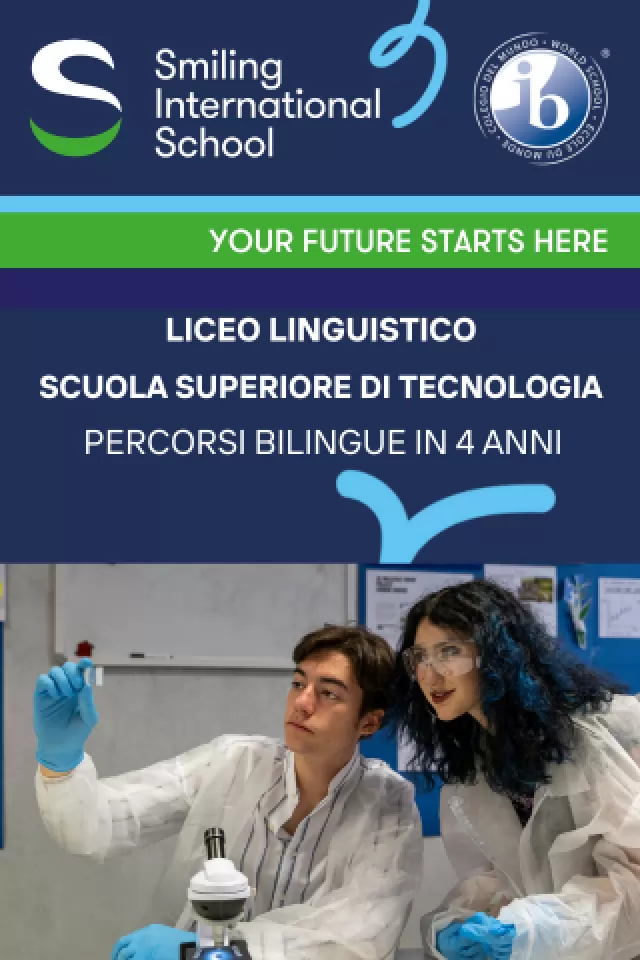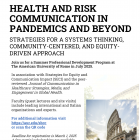Orvieto: a perfect day trip from Rome
How to get to and what to see in Orvieto. The hilltop city makes a delightful day trip from Rome.
Situated in the province of Terni in south-west Umbria, Orvieto stands on the summit of a large outcrop of volcanic tufa rock, roughly halfway between Rome and Florence.A trip to this charming cathedral city is always a pleasure but those arriving by public transport are in for a double treat. A funicular cable railway takes visitors up the 157-m cliff in an exhilarating, three-minute journey.St. Patrick's Well
Arrival in the historic Etruscan city is made all the more bizarre in that most first-time visitors immediately make for St Patrick’s Well, retracing their steps by descending its 54-m depths.This murky marvel of engineering was commissioned by Pope Clement VII following his refuge in Orvieto during the sack of Rome in 1527. The Medici pope entrusted fellow Florentine Antonio da Sangallo the Younger with designing the well, to ensure a reliable water supply for this potentially-regular papal retreat.The structure’s two concentric spiral staircases operate independently of each other, one for descending and the other for ascending, and are illuminated by 70 windows carved into the central shaft.
Modern-day visitors can still traverse the well’s 248 steps, cut large enough to accommodate the pack donkeys once used to carry water to the surface. However it is worth noting – particularly for those with children – that the majority of the windows are knee-high and bereft of barriers.
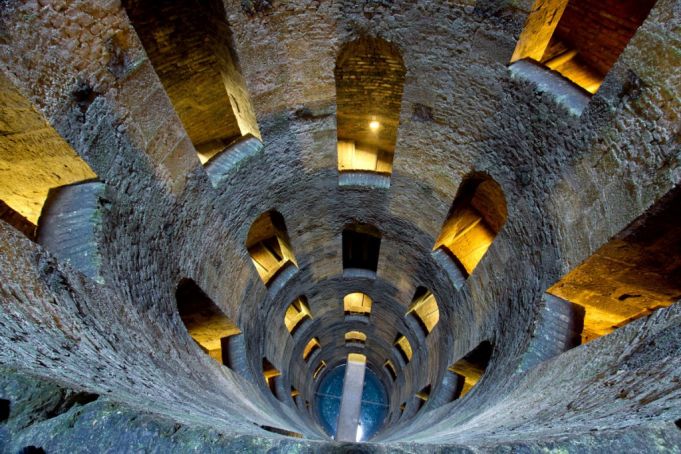
Albornoz Fortress
Once back in daylight, people can catch their breath while enjoying the wonderful views of Umbrian countryside from the nearby Fortezza Albornoz. Commissioned by Pope Innocent VI, the fortress was built in 1364 by the Spanish cardinal and papal legate Egidio Albornoz. From here it is a 15-minute stroll or five-minute bus trip into town.The virtually traffic-free centro storico is dominated by the enormous 14th-century cathedral whose very existence is the result of a miracle. In 1263 a Bohemian priest, doubting the Catholic doctrine of transubstantiation or the real presence of Christ in the Eucharist, set off on a pilgrimage to Rome.While visiting a church in Bolsena, close to Orvieto, he is said to have witnessed blood dripping out of a consecrated host during Mass. The blood-soaked altar cloth (or corporal) is still housed in a silver-gilt reliquary in the cathedral today and venerated each year on the feast of Corpus Christi, which commemorates the institution of the Holy Eucharist.
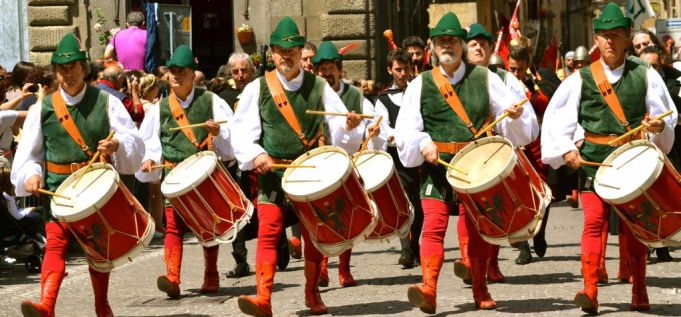
Duomo di Orvieto
Construction continued over the subsequent three decades, overseen by multiple architects who each left their mark by incorporating the changing architectural trends.The cathedral’s interior is characterised by black and white-striped walls and columns, and includes an ornate 16thcentury organ case with 5,585 pipes as well as a remarkable Pietà, which local sculptor Ippolito Scalza spent nine years carving from a single block of marble.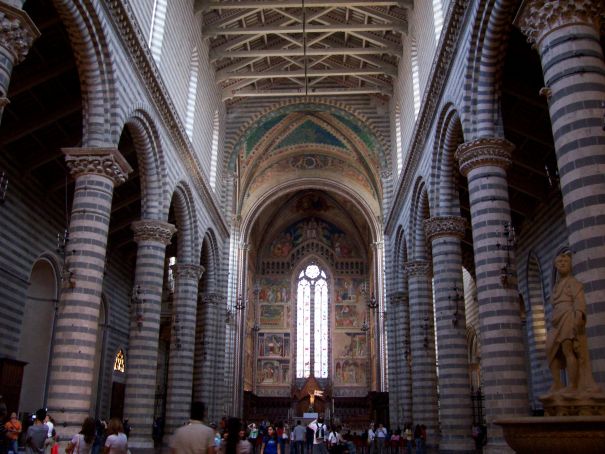
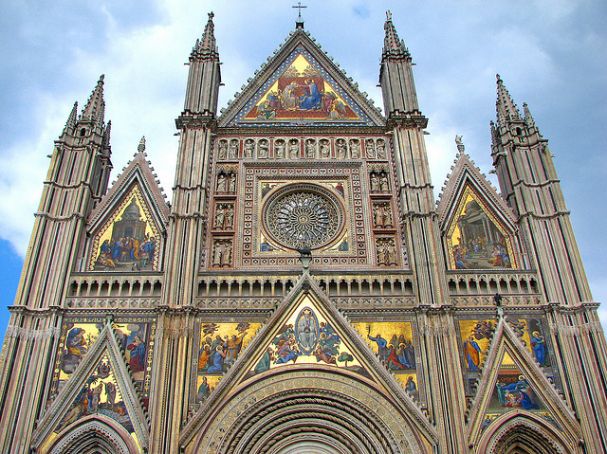
History of Orvieto
Delving further back into Orvieto’s history, it was first inhabited by Etruscans from the ninth century BC until 264 BC when the territory was conquered by Romans after a two-year assault.The reason the Etruscans managed to hold out so long was due to their intricate system of tunnels, cellars, wells and escape hatches, some of which can still be visited today.Among these is the 36m-deep Pozzo della Cava, an Etruscan well that was extended in 1527 and dug entirely by hand.
However Orvieto is far from being solely the realm of historians. Although it has only around 21,000 inhabitants the city is alive and vibrant, while its refined sense of culture tends to attract the more discerning visitor.Festivals and pageants
The well-kept streets play host to festivals all year round, including the prestigious Umbria Winter Jazz festival which has been taking place every December for the last 40 years, and the mediaeval-style Corpus Christi pageant which generates large crowds each summer. The elegant, neoclassical Teatro Mancinelli is particularly active and its 560 seats are regularly filled with lovers of drama, comedy, dance and music.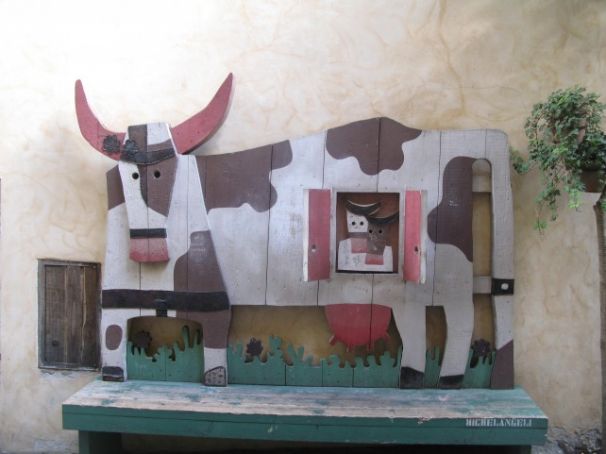
The numerous shops selling brightly decorated ceramics do a roaring trade, helped by the steady flow of tourists, many of whom are drawn to the colourful wooden sculptures on Via Michelangeli near the duomo. This alley is home to a workshop where five generations of Michelangeli woodworkers have enlivened their environs with a series of jolly, much-photographed timber sculptures.
Food
Orvieto surpasses itself in terms of cuisine from its surrounding region, and it regularly hosts food festivals such as Orvieto con gusto.The city is a member of Cittaslow, the slow food movement, and is famed for its wines and local products such as caciotta and pecorino cheeses, truffles, cinghiale (wild boar), tozzetti almond biscuits and the snail shell-shaped lumachelle made from pizza dough with pancetta and cheese.Meanwhile those with a sweet tooth can’t fail to be attracted by the aroma drifting from Cioccolateria Dolceamaro, which offers all manner of artisan chocolate delicacies including trimmings from the unexpected chocolate kebab.By Andy DevaneThis article was originally published in the March 2014 edition of Wanted in Rome magazine.
Orvieto information
What to do in Orvieto
- Pozzo di S. Patrizio, Viale S. Gallo, tel. 0763343768.
- Orvieto Cathedral, Piazza del Duomo.
- Pozzo della Cava, Via della Cava 28, tel. 0763342373, www.pozzodellacava.it.
- Teatro Mancinelli, Corso Cavour 122, tel. 0763340493, www.teatromancinelli.com.
- Umbria Winter Jazz (Dec-Jan), www.umbriajazz.com.
- Corpus Christi, (the date changes each year, depending on Easter).
- Orvieto con Gusto, food festival, April and October, www.orvietocongusto.it.
Where to eat in Orvieto
- L’Oste del Re, Corso Cavour 58, tel. 0763343846, www.ostedelreorvieto.com.
- Ristorante Maurizio, Via del Duomo 78, tel. 0763341114, www.ristorantemaurizio.it.
- Cioccolateria Dolceamaro, Corso Cavour 78, www.cioccolateriaorvieto.com.
How to get to Orvieto
- By car: Orvieto is on the A1 autostrada about half way between Rome and Florence. Lots of parking outside city centre.
- By train: There are regular fast trains between Rome and Orvieto Scala. The funicular terminus up to the old hill-top town is just across the road from the station.
Tourist information
- www.orvietoviva.com.
- Tourist office, Piazza Duomo 24, tel. 0763341772.
General Info
View on Map
Orvieto: a perfect day trip from Rome
05018 Orvieto, Province of Terni, Italy






